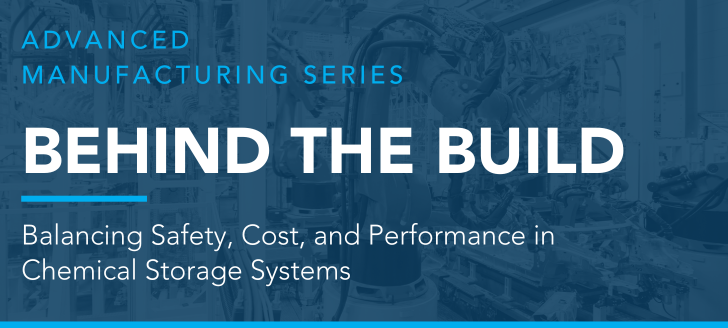
Balancing Safety, Cost, and Performance in Chemical Storage Systems
Chemical storage and distribution systems are a critical backbone of many manufacturing operations, ensuring that raw materials, process chemicals, and treatment agents are delivered safely, reliably, and in compliance with strict regulations. These systems are subject to stringent design, handling, and permitting requirements due to the potential hazards they present to personnel, equipment, and the environment. Asking the right questions early, both chemical suppliers and your Authority Having Jurisdiction (AHJ) will allow you to develop a system design that balances safety, operational efficiency, compliance, and lifecycle cost.
What to Know About Your Chemical storage and Distribution Needs
- Chemical Types & Properties:
Identify all chemicals used in your process and gather SDS sheets to identify hazardous classifications, physical states, concentrations, and compatibility. This will guide material selection for tanks, piping, and fittings as well as facility layout. - Usage Rates & Demand Profiles:
Understand daily, weekly, and peak consumption rates to size bulk storage appropriately and design distribution systems that maintain stable supply under variable demand. Identify local suppliers and understand delivery cadences and chemical availability to guide inventory capacities. - Regulatory & Safety Criteria:
Be aware of requirements under IBC, OSHA, NFPA, EPA, and local fire marshals — including containment volume, ventilation, monitoring, and spill control which is driven by occupancy classification.
Key Considerations for System Design
- Storage Capacity:
Determine optimal tank sizing based on bulk delivery schedules, safety stock requirements, and available space, while avoiding overcapacity that ties up capital. Evaluate maximum allowable quantities (MAQs) for various chemical classifications based on designated building code classification for the intended storage location. - Containment & Spill Control:
Design secondary containment with compatible liners and sump drainage controls. - Material Compatibility:
Select tanks, pumps, valves, and piping materials (e.g., HDPE, PVDF, stainless steel) that are fully compatible with the stored chemicals to prevent corrosion, contamination, and failures. - Distribution & Delivery Method:
Choose between pressurized lines, metering pumps, or gravity-fed systems based on process requirements, safety considerations, and redundancy needs. - Monitoring & Controls:
Incorporate leak detection, tank level sensors, and flow monitoring to ensure continuous oversight, prevent overfilling, and support preventive maintenance.
Strategies for Cost & Schedule Optimization
- Consolidate Chemical Deliveries:
Whenever possible, standardize chemicals across multiple processes to reduce the number of tanks, pumps, and delivery points. - Plan for Lifecycle Maintenance:
Design in accessibility for tank inspection, pump replacement, and spill cleanup to minimize downtime. - Engage Early with Regulators & Suppliers:
Early coordination can reduce approval delays, avoid costly redesigns, and ensure system performance aligns with chemical supply logistics.
At ARCO/Murray, we design and build chemical storage and distribution systems that meet stringent safety and compliance requirements while supporting seamless manufacturing operations. Our approach focuses on smart system sizing, strategic component selection, and cost-conscious construction to deliver projects that are safe, compliant, and operationally efficient from day one.
Where do you see the biggest challenges in your chemical handling processes? Let’s talk.

Nick Wright, P.E.
Project Manager

Nick O’Hare
Director of
Business Development